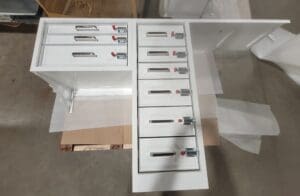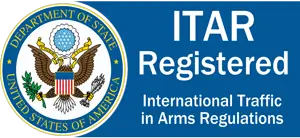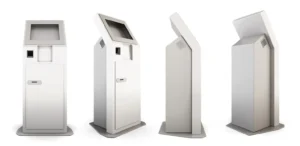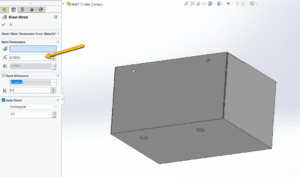Last updated on April 1st, 2025 at 09:22 am
Corrosion occurs when environmental conditions trigger a chemical reaction that converts refined metal into its hydroxide, oxide, or sulfide form. In ferrous metals, corrosion causes rust, the orange, powdery crust we’re all familiar with. In non-ferrous metals, corrosion causes pitting and the formation of a milky-white film.
Corrosion impacts more than a part’s appearance; it also puts its structural integrity at risk. However, it is possible to prevent corrosion from occurring! These anti-corrosion practices will protect your sheet metal parts and ensure they maintain superior functionality and appearance:
Table of Contents
- 1 Corrosion Mechanisms & Engineering Considerations
- 2 1. Design for the Environment
- 3 2. Collaborate with Your Fabricator
- 4 3. Choose a Non-Corrosive Material
- 5 4. Apply a Protective Finish
- 6 Talk to ASM About Your Corrosion Concerns
- 7 Design Corrosion Resistant Sheet Metal Parts
- 7.0.1 What causes corrosion in sheet metal parts?
- 7.0.2 How can I design sheet metal parts to prevent corrosion?
- 7.0.3 What materials are best for preventing corrosion in sheet metal parts?
- 7.0.4 What protective finishes can be applied to sheet metal parts to prevent corrosion?
- 7.0.5 How can collaborating with a fabricator help in preventing corrosion in sheet metal parts?
Corrosion Mechanisms & Engineering Considerations
Corrosion is a natural process that degrades metal when it reacts with its environment. Understanding the different types of corrosion and the factors influencing their progression is crucial for designing long-lasting, corrosion-resistant sheet metal parts.
Common Corrosion Mechanisms
Uniform Corrosion – This occurs evenly across the metal surface due to exposure to moisture, oxygen, or chemicals. While predictable, it still compromises structural integrity over time.
Galvanic Corrosion – Happens when two dissimilar metals are in contact in the presence of an electrolyte (e.g., water). The more reactive metal (anode) corrodes faster while the other (cathode) remains protected. Engineers can prevent this by selecting metals with similar electrochemical properties or using insulating coatings.
Pitting Corrosion – A localized form of corrosion that creates small holes or pits in the material. This is common in stainless steel when exposed to chlorides (e.g., saltwater environments). Proper alloy selection and protective coatings help mitigate this issue.
Crevice Corrosion – Occurs in narrow gaps, such as bolted joints or overlaps, where stagnant moisture creates an aggressive localized environment. Designing for proper drainage and sealants can help prevent crevice corrosion.
Stress Corrosion Cracking (SCC) – A combination of tensile stress and a corrosive environment can lead to sudden material failure. Materials like austenitic stainless steel are prone to SCC in chloride-rich conditions, making material selection critical.
Intergranular Corrosion – When grain boundaries in metals are attacked due to improper heat treatment or high-temperature exposure. Solution heat treatment and stabilized grades of stainless steel (e.g., 316L) can prevent this.
1. Design for the Environment
Because moisture accelerates corrosion, strive to avoid features that trap moisture, dirt, salt, and other grime. Whenever possible, make design decisions that allow the part to drain and dry, especially when you know it will be exposed to liquids or used in humid environments.
2. Collaborate with Your Fabricator
Before finalizing your design, let your fabricator take a look. Here at Approved Sheet Metal, we’re happy to review our customers’ precision sheet metal designs and discuss any potential problems we anticipate. When you communicate with us about your part’s intended use, we can assist you with material selection and other anti-corrosion solutions.
3. Choose a Non-Corrosive Material
The material you select for your precision sheet metal project plays a critical role in preventing corrosion. If non-corrosive materials aren’t an option for your application, we can still help you protect your parts—more on that in a moment!
First, take a look at these common sheet metal materials that perform well in corrosive environments:
- Stainless steel. The alloy’s chromium content forms a passive oxidation layer that prevents corrosion.
- Aluminum. Grades 1xxx, 3xxx, and 5xxx are most resilient in corrosive environments. Anodizing adds an anti-corrosion layer to other aluminum grades.
- Superalloys. Formed with nickel, cobalt, or iron, superalloys are preferred by aerospace and medical customers requiring corrosion resistance and excellent mechanical properties.
- Copper alloys. These alloys offer good corrosion resistance, with bronze and brass being the most popular options.
- Titanium. This metal’s passive oxides help it resist corrosion.
Warning: carbon steel is highly prone to corrosion
Carbon steel is so prone to corrosion that even the moisture from a person’s hands can cause it to rust. Protective coatings are imperative on all carbon steel parts, even those not destined for harsh environments.
The heat from welding generates toxic fumes from carbon steel, but the same secondary processes that prevent corrosion will also render the material nontoxic.
4. Apply a Protective Finish
Ask ASM to pair your part with a surface finish appropriate for its application and environmental exposure. In some cases, a single treatment will serve to enhance a part’s beneficial properties while also preventing corrosion. Anti-corrosion coatings create a physical barrier that protects the metal’s surface from moisture, grime, and other corrosive substances.
Stick with these standard specifications:
- Clear Chromate: MIL-DTL-5541 Class 1A Clear
- Yellow Chromate: MIL-DTL-5541 Class 1A Yellow
- Clear Zinc: ASTM-B633 Type I FE/ZN 5 SCI Zinc
- Yellow Zinc: ASTM-B633 Type II FE/ZN 5 SCI Yellow
- Black Zinc: ASTM-B633 Type II FE/ZN 5 SCI Black
- Clear Anodize: MIL-A-8625 Type II Class 1
- Hard Clear Anodize: MIL-A-8625 Type III Class 1
- Black Anodize: MIL-A-8625 Type II Class 2 Black
- Hard Black Anodize: MIL-S-8625 Type III Class 2 Black
- Color Anodize: MIL-A-8625 Type II Class 2 “Color”
- Passivate: ASTM-A967 Nitric 2 Practice D
- Electroless Nickel: ASTM-B733 Type IV SCI Class 1
- Electropolish: ASTM-B912 Electropolish
- Tin Plate: ASTM-B545 Class A Tin Light Service Condition .0001”
Chrome plating

Hard chrome plating provides good corrosion resistance. Or, you can upgrade to black chrome plating for even better protection against corrosion.
Pre-plated materials are also available, but once cut, the edges become re-exposed to the environment and can eventually rust. If corrosion resistance is critical, we recommend starting with unplated material and plating the part after fabrication.
Powder coating
Powder coating forms a corrosion-resistant layer of polymer on a part’s surface. However, because powder coating blocks conductivity, it isn’t suited to all applications.
Anodizing
The protective oxide layer that naturally occurs on certain materials is very thin—about 4 nanometers—so it’s wise to enhance that anti-corrosion layer by anodizing your precision sheet metal parts. Anodizing also comes in many colors and can add an aesthetic touch to your sheet metal project.
Painting
Wet paint is a low-cost anti-corrosion solution that can also improve a part’s cosmetic appearance. This passive barrier layer is very effective, though it can be scratched or chipped, exposing the metal to the environment.
Galvanizing
Beyond coating a material’s surface, galvanizing chemically bonds with the metal to form a strong physical barrier against corrosion. Galvanizing is used to prevent corrosion on a wide range of products, from bridges to automobiles.
Talk to ASM About Your Corrosion Concerns
Begin every new precision sheet metal fabrication project with a conversation, and our experts will gladly guide you toward the best processes for your goals. With your corrosion-resistant, superior-quality part in hand, you’ll be glad you partnered with Approved Sheet Metal!
Design Corrosion Resistant Sheet Metal Parts
Corrosion occurs when environmental conditions trigger a chemical reaction that converts refined metal into its hydroxide, oxide, or sulfide form. In ferrous metals, this process results in rust, while in non-ferrous metals, it causes pitting and the formation of a milky-white film.
To prevent corrosion, design parts to avoid features that trap moisture, dirt, salt, and other grime. Ensure that parts can drain and dry, especially if they will be exposed to liquids or used in humid environments.
Materials that perform well in corrosive environments include:
- Stainless steel, which forms a passive oxidation layer
- Aluminum, particularly grades 1xxx, 3xxx, and 5xxx
- Superalloys made with nickel, cobalt, or iron
- Copper alloys, such as bronze and brass
- Titanium, which resists corrosion due to its passive oxides
Several protective finishes can be applied to prevent corrosion, including:
- Clear Chromate: MIL-DTL-5541 Class 1A Clear
- Yellow Chromate: MIL-DTL-5541 Class 1A Yellow
- Clear Zinc: ASTM-B633 Type I FE/ZN 5 SCI Zinc
- Black Zinc: ASTM-B633 Type II FE/ZN 5 SCI Black
- Clear Anodize: MIL-A-8625 Type II Class 1
- Hard Clear Anodize: MIL-A-8625 Type III Class 1
- Passivate: ASTM-A967 Nitric 2 Practice D
- Electroless Nickel: ASTM-B733 Type IV SCI Class 1
- Powder coating
- Anodizing
- Wet painting
- Galvanizing




